
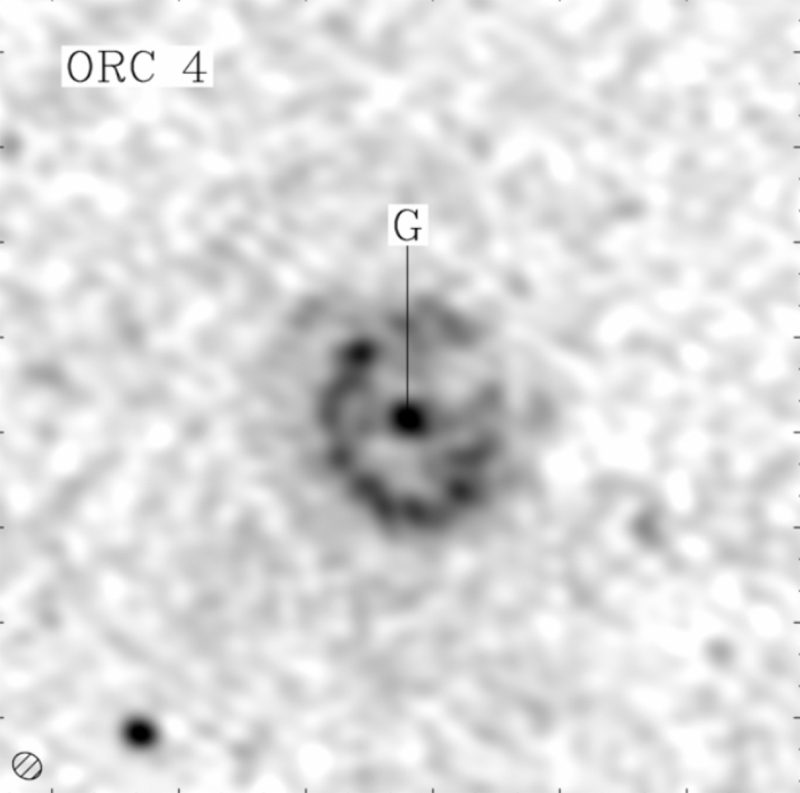
Odd Radio Circle – aka ORC – number 4. The ASKAP radio telescope in Australia spotted the 4 ORCS in 2019. Image via Norris et al./ arXiv/ ScienceAlert.
Our universe is full of weird and wonderful things, and astronomers keep making new and increasingly bizarre discoveries. The latest discovery has them going in circles, literally. Using a radio telescope, astronomers at Western Sydney University in Australia spotted four unusual objects in deep space that look like a ring or bubble. They’ve dubbed them Odd Radio Circles or ORCs because they are circular … and so odd.
The researchers have submitted a new paper to Nature Astronomy, where it is currently awaiting peer review.
As explained in the paper’s abstract:
We have found an unexpected class of astronomical objects which have not previously been reported, in the Evolutionary Map of the Universe Pilot [EMU]survey, using the Australian Square Kilometre Array Pathfinder telescope (ASKAP).
The objects appear in radio images as circular edge-brightened discs about one arc-minute diameter, and do not seem to correspond to any known type of object. We speculate that they may represent a spherical shock wave from an extra-galactic transient event, or the outflow, or a remnant, from a radio galaxy viewed end-on.
In other words, they don’t know what they’ve found. They can only speculate.
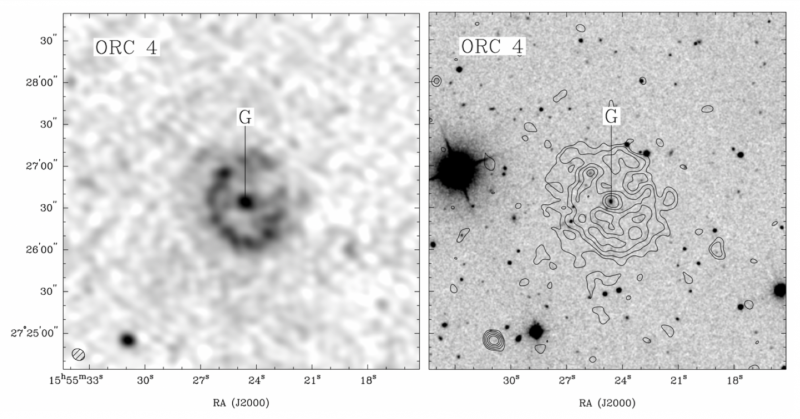
Radio image of ORC 4 again, found in archival data from 2013 (left), along with a contour map of the ring (right). Image via Norris et al./ arXiv.
Radio telescopes are able to “see” various kinds of circular objects in space. What makes these ORCs unique? From the paper:
Circular features are well-known in radio astronomical images, and usually represent a spherical object such as a supernova remnant, a planetary nebula, a circumstellar shell [composed of circumstellar dust], or a face-on disc such as a protoplanetary disk or a star-forming galaxy.
They may also arise from imaging artifacts [lens flares] around bright sources …
Here we report the discovery of a class of circular feature in radio images that do not seem to correspond to any of these known types of object or artifact, but rather appear to be a new class of astronomical object.
Scientists first noticed the ORCs in images from the late 2019 Pilot Survey of the Evolutionary Map of the Universe (EMU). The images were collected using ASKAP, one of the world’s most highly sensitive radio telescope arrays.
First, one faint circle was seen in the images, then another. Then the astronomers found a third. Were they glitches? One or two maybe, but three?
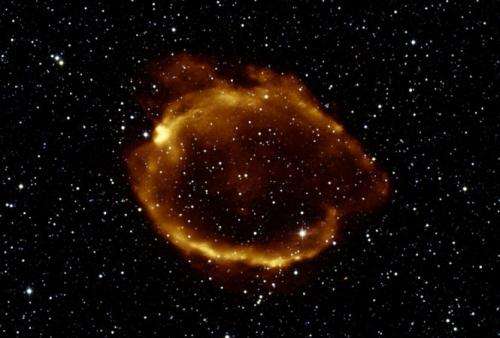
One idea was that ORCs might be supernova remnants like this one, G299.2-2.9, but there would need to be many more such remnants than are known to exist in our galaxy. Image via X-ray: NASA/ CXC/ U.Texas/ S. Park et al/ ROSAT/ 2MASS/ UMass/ IPAC-Caltech/ NASA/ NSF/ Phys.org.
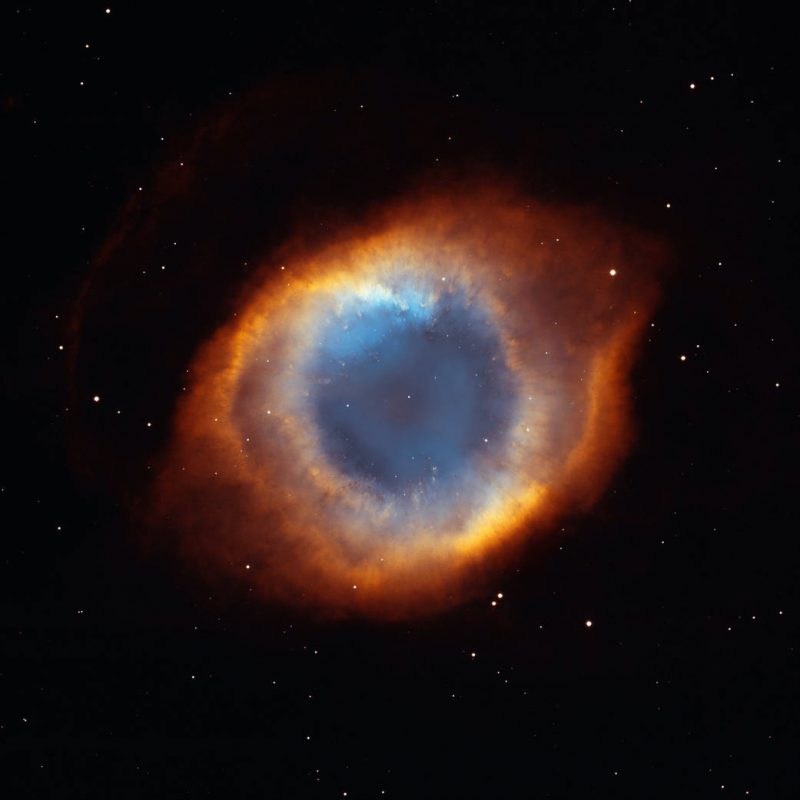
Another possibility was that ORCs are planetary nebulae, like the Helix Nebula. But the radio spectral index of such a nebula is not consistent with the radio spectral index of ORCs. In other words, the observational details of planetary nebulae don’t match those of ORCs. Image via NASA.
Then, a fourth ORC was found in archived data from 2013. In that case, the Giant Metrewave Radio Telescope (GMRT) had been used, a few years before ASKAP began observing.
ORC 1 and ORC 2 were then later observed again using using yet another telescope, the Australian Telescope Compact Array (ATCA). All of these observations showed that these were real objects, not just glitches with ASKAP.
So scientists now accepted that these strange objects were real phenomena, ones that had not been seen before. But what were they?
We still don’t know.
What we do know is that all four ORCs are found at high galactic latitudes, well away from the plane of the galaxy, the flat part containing our sun and most other Milky Way stars. And, as observed, the ORCs are about one arcminute in size (a 60th of a degree or about 3% of the size of the moon).
Scientists still don’t know how far away they are. That’s a big gap in our knowledge about these objects, since, for many objects, the distance away can provide clues to the objects’ identities.
The ORCs are visible only at radio wavelengths, with radio telescopes. They can’t be seen at all in X-ray, optical or infrared wavelengths. Two of the ORCs have a galaxy near the center of the circles, but the other two don’t. ORC 3 appears as a uniform disk, while the other three look more like rings.
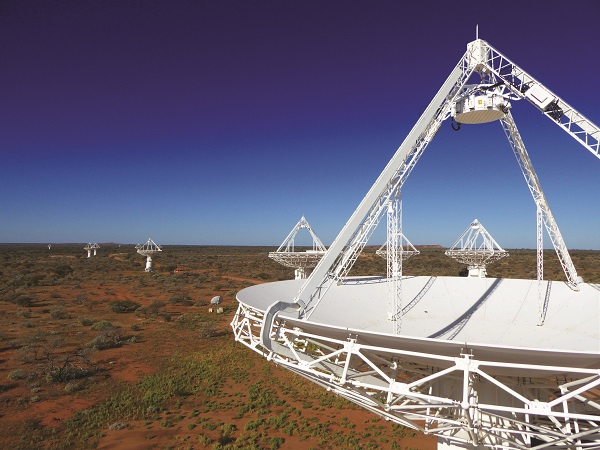
The Australian Square Kilometre Array Pathfinder, which first detected the ORCs in 2019. Image via Australia Telescope National Facility (ATNF).
Could they be supernova remnants or planetary nebulae, two other well-known kinds of cosmic rings? There’s a similarity, but the researchers say no. They are unlikely to be supernova remnants because three of the ORCs were found in a very small patch of sky. That would imply they were very common, and there would need to be at least 50,000 such supernova remnants in our galaxy to make the numbers work. But astronomers only know of about 350.
So what else could they be? One idea is that they might be huge circular shockwaves from some massive event(s), outside the galaxy. As the researchers noted in the paper:
Several such classes of transient events, capable of producing a spherical shock wave, have recently been discovered, such as fast radio bursts, gamma-ray bursts and neutron star mergers. However, because of the large angular size of the ORCs, any such transients would have taken place in the distant past.
It is also possible that the ORCs represent a new category of a known phenomenon, such as the jets of a radio galaxy or blazar when seen end-on, down the ‘barrel’ of the jet. Alternatively, they may represent some remnant of a previous outflow from a radio galaxy.
Since the discovery of these first four ORCs, the researchers have identified six other candidate ORCs that are fainter.

Ray Norris at Western Sydney University in Australia, who led the new study. Image via The Conversation.
The ORCs are a fascinating new mystery for astronomers. For those with a truly speculative turn of mind, it might be natural to wonder if they could be artificial in origin. Right now, however, there’s no way to determine that possibility. For now, the ORCs are considered to be most likely natural phenomena. Stay tuned, as astronomers continue to probe for answers.
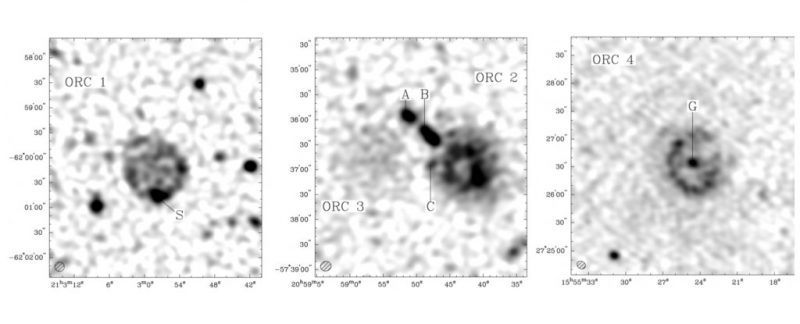
Three of the 4 Odd Radio Circles (ORCs) discovered by the Australian Square Kilometre Array Pathfinder (ASKAP) radio telescope in 2019. Image via Norris et al./ arXiv/ ScienceAlert.
Bottom line: Astronomers have discovered four Odd Radio Circles outside of our galaxy.
Source: Unexpected Circular Radio Objects at High Galactic Latitude
from EarthSky https://ift.tt/32PNCdT


Odd Radio Circle – aka ORC – number 4. The ASKAP radio telescope in Australia spotted the 4 ORCS in 2019. Image via Norris et al./ arXiv/ ScienceAlert.
Our universe is full of weird and wonderful things, and astronomers keep making new and increasingly bizarre discoveries. The latest discovery has them going in circles, literally. Using a radio telescope, astronomers at Western Sydney University in Australia spotted four unusual objects in deep space that look like a ring or bubble. They’ve dubbed them Odd Radio Circles or ORCs because they are circular … and so odd.
The researchers have submitted a new paper to Nature Astronomy, where it is currently awaiting peer review.
As explained in the paper’s abstract:
We have found an unexpected class of astronomical objects which have not previously been reported, in the Evolutionary Map of the Universe Pilot [EMU]survey, using the Australian Square Kilometre Array Pathfinder telescope (ASKAP).
The objects appear in radio images as circular edge-brightened discs about one arc-minute diameter, and do not seem to correspond to any known type of object. We speculate that they may represent a spherical shock wave from an extra-galactic transient event, or the outflow, or a remnant, from a radio galaxy viewed end-on.
In other words, they don’t know what they’ve found. They can only speculate.

Radio image of ORC 4 again, found in archival data from 2013 (left), along with a contour map of the ring (right). Image via Norris et al./ arXiv.
Radio telescopes are able to “see” various kinds of circular objects in space. What makes these ORCs unique? From the paper:
Circular features are well-known in radio astronomical images, and usually represent a spherical object such as a supernova remnant, a planetary nebula, a circumstellar shell [composed of circumstellar dust], or a face-on disc such as a protoplanetary disk or a star-forming galaxy.
They may also arise from imaging artifacts [lens flares] around bright sources …
Here we report the discovery of a class of circular feature in radio images that do not seem to correspond to any of these known types of object or artifact, but rather appear to be a new class of astronomical object.
Scientists first noticed the ORCs in images from the late 2019 Pilot Survey of the Evolutionary Map of the Universe (EMU). The images were collected using ASKAP, one of the world’s most highly sensitive radio telescope arrays.
First, one faint circle was seen in the images, then another. Then the astronomers found a third. Were they glitches? One or two maybe, but three?

One idea was that ORCs might be supernova remnants like this one, G299.2-2.9, but there would need to be many more such remnants than are known to exist in our galaxy. Image via X-ray: NASA/ CXC/ U.Texas/ S. Park et al/ ROSAT/ 2MASS/ UMass/ IPAC-Caltech/ NASA/ NSF/ Phys.org.

Another possibility was that ORCs are planetary nebulae, like the Helix Nebula. But the radio spectral index of such a nebula is not consistent with the radio spectral index of ORCs. In other words, the observational details of planetary nebulae don’t match those of ORCs. Image via NASA.
Then, a fourth ORC was found in archived data from 2013. In that case, the Giant Metrewave Radio Telescope (GMRT) had been used, a few years before ASKAP began observing.
ORC 1 and ORC 2 were then later observed again using using yet another telescope, the Australian Telescope Compact Array (ATCA). All of these observations showed that these were real objects, not just glitches with ASKAP.
So scientists now accepted that these strange objects were real phenomena, ones that had not been seen before. But what were they?
We still don’t know.
What we do know is that all four ORCs are found at high galactic latitudes, well away from the plane of the galaxy, the flat part containing our sun and most other Milky Way stars. And, as observed, the ORCs are about one arcminute in size (a 60th of a degree or about 3% of the size of the moon).
Scientists still don’t know how far away they are. That’s a big gap in our knowledge about these objects, since, for many objects, the distance away can provide clues to the objects’ identities.
The ORCs are visible only at radio wavelengths, with radio telescopes. They can’t be seen at all in X-ray, optical or infrared wavelengths. Two of the ORCs have a galaxy near the center of the circles, but the other two don’t. ORC 3 appears as a uniform disk, while the other three look more like rings.

The Australian Square Kilometre Array Pathfinder, which first detected the ORCs in 2019. Image via Australia Telescope National Facility (ATNF).
Could they be supernova remnants or planetary nebulae, two other well-known kinds of cosmic rings? There’s a similarity, but the researchers say no. They are unlikely to be supernova remnants because three of the ORCs were found in a very small patch of sky. That would imply they were very common, and there would need to be at least 50,000 such supernova remnants in our galaxy to make the numbers work. But astronomers only know of about 350.
So what else could they be? One idea is that they might be huge circular shockwaves from some massive event(s), outside the galaxy. As the researchers noted in the paper:
Several such classes of transient events, capable of producing a spherical shock wave, have recently been discovered, such as fast radio bursts, gamma-ray bursts and neutron star mergers. However, because of the large angular size of the ORCs, any such transients would have taken place in the distant past.
It is also possible that the ORCs represent a new category of a known phenomenon, such as the jets of a radio galaxy or blazar when seen end-on, down the ‘barrel’ of the jet. Alternatively, they may represent some remnant of a previous outflow from a radio galaxy.
Since the discovery of these first four ORCs, the researchers have identified six other candidate ORCs that are fainter.

Ray Norris at Western Sydney University in Australia, who led the new study. Image via The Conversation.
The ORCs are a fascinating new mystery for astronomers. For those with a truly speculative turn of mind, it might be natural to wonder if they could be artificial in origin. Right now, however, there’s no way to determine that possibility. For now, the ORCs are considered to be most likely natural phenomena. Stay tuned, as astronomers continue to probe for answers.

Three of the 4 Odd Radio Circles (ORCs) discovered by the Australian Square Kilometre Array Pathfinder (ASKAP) radio telescope in 2019. Image via Norris et al./ arXiv/ ScienceAlert.
Bottom line: Astronomers have discovered four Odd Radio Circles outside of our galaxy.
Source: Unexpected Circular Radio Objects at High Galactic Latitude
from EarthSky https://ift.tt/32PNCdT

Aucun commentaire:
Enregistrer un commentaire